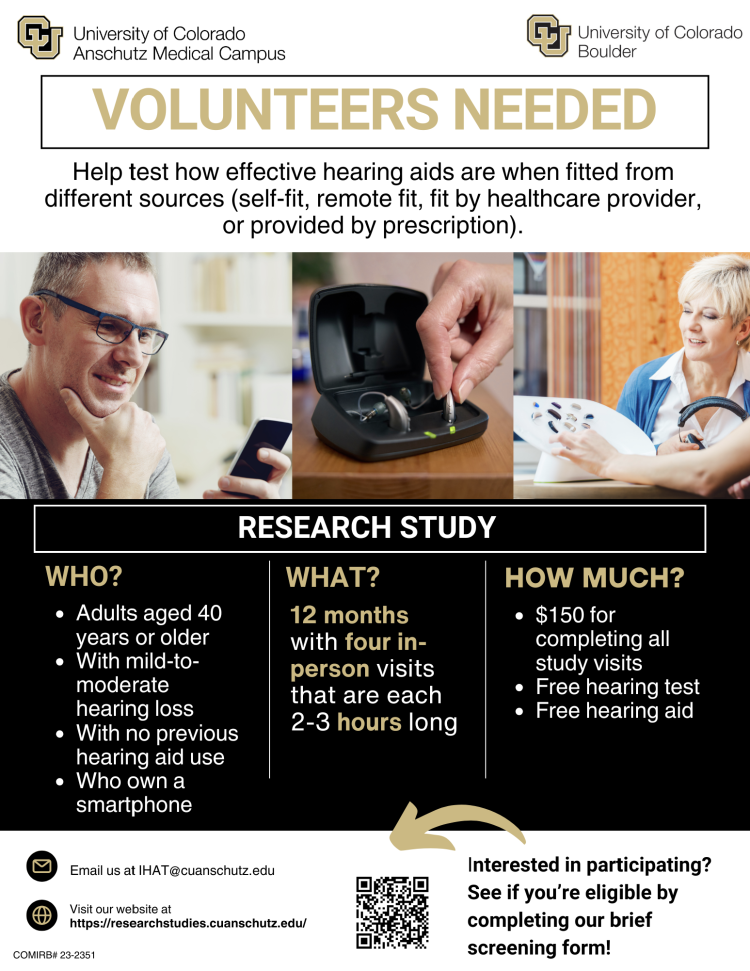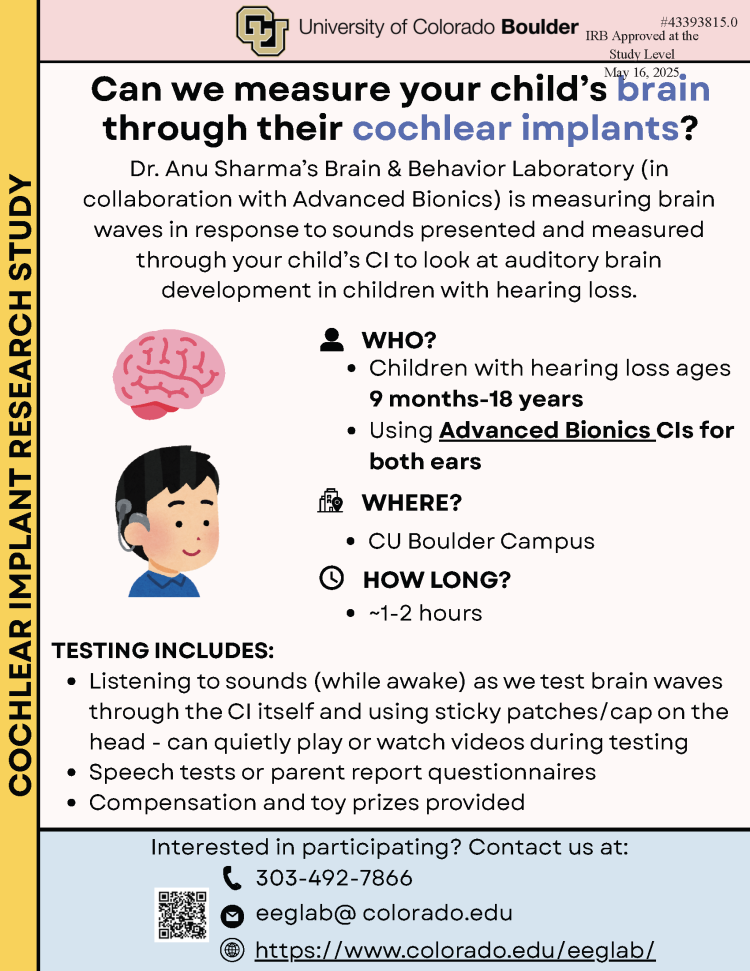Current Projects
Innovations in Hearing Accessibility and Technology (IHAT)
Neuroplasticity with hearing aids
- We are interested in examining behavioral, cognitive, and neuroplastic changes in adults with hearing loss. In this study, we utilize high-density EEG to examine cortical auditory, visual, and somatosensory neuroplasticity in both prescription and over-the-counter hearing aid users. We are examining how brain measures are related to behavioral measures, such as speech perception in noise, as well as subjective measures of hearing aid satisfaction and benefit. This study is being done in collaboration with Dr. Vinaya Manchaiah at University of Colorado Anschutz Medical Campus.
If you would like to participate in this study, please see the study flyer at the bottom of this page.
If you have additional questions, please email IHAT@cuanschutz.edu
Central Auditory Development in Special Pediatric Populations with Hearing Loss: Children with Hearing Aids and Cochlear Implants, ANSD, Cochlear Nerve Deficiency, and Multiple Disabilities
- The developing auditory cortex demonstrates a high level of neuroplasticity. As such, the auditory cortex is both primed to mature normally and at risk for re-organizing abnormally, depending upon numerous factors such as whether adequate auditory stimulation is provided to the auditory cortex and whether there is appropriate timing of this stimulation. We are continuing to investigate the use of non-invasive cortical auditory evoked potentials (CAEPs), particularly the P1 CAEP biomarker, in evaluating the developmental maturation of the central auditory pathways in special pediatric populations with hearing loss, including children with hearing aids and cochlear implants, children with auditory neuropathy spectrum disorder (ANSD), children with cochlear nerve deficiency, and children with multiple disabilities. From a clinical perspective, research in this area may lead to the development of more targeted and effective rehabilitation programs for children with hearing impairment who receive audiological intervention, and the P1 CAEP biomarker may prove useful in providing objective measures of benefit after audiological intervention.
If you would like your child to participate in this study, please email eeglab@colorado.edu
Cortical Auditory Evoked Potentials Measured Directly Through Cochlear Implants
- We are investigating recording P1 cortical auditory evoked potentials (CAEP) entirely through the cochlear implant itself. We are additionally examining the relationship of CAEPs to behavioral speech perception outcomes. This project aims to advance clinical practice by examining if the P1 CAEP biomarker can be reliably recorded directly from the cochlear implant, eliminating the need for traditional scalp electrodes and creating a more clinically viable method for monitoring cortical auditory development in patients with cochlear implants.
If you or your child would like to participate in this study, please see the study flyer at the bottom of this page.
If you have additional questions, please email eeglab@colorado.edu
Auditory Cortical Maturation in Conductive Hearing Loss
- We are interested in auditory cortical maturation in children and adults with conductive hearing losses, such as in microtia/atresia, including those wearing bone conduction hearing aids or osseointegrated devices. Testing includes cortical evoked potential testing, where participants listen to sounds or view shapes as we measure their brain responses using several EEG electrodes or high-density EEG caps.
- We are additionally collaborating with Dr. Sarah Gitomer and Dr. Megan Hedman at the Children's Hospital of Colorado to complete cortical evoked potential testing in the Microtia/Atresia clinic.
If you or your child would like to participate in this study, please email eeglab@colorado.edu
Brain Plasticity in Cochlear Implant Users
- We are recruiting unilateral, bilateral, and single-sided deafness (SSD) cochlear implant users to study how the brain adapts to the cochlear implant.
If you are interested in participating in this study, please contact eeglab@colorado.edu
IHAT Research Flyer

Pediatric CI Research Flyer


